An E-Commerce Platform for Industrialized Construction Procurement Based on BIM and Linked Data
Abstract
1. Introduction
2. E-Commerce in the Construction Industry
- Large volumes of information: With increases in enterprise production capacity and the expansion of sale reach, there are more and more companies involved in e-commerce, offering many kinds of products and services. The amount of commercial information has thus increased sharply [42].
- Fragmented information: Information in different e-commerce platforms hosted independently, so when users search for relevant information on the network, it is displayed online in different formats. It is difficult to apply a query across all relevant information [43], mainly due to the separation of information between different websites.
- Diversified information: In the construction industry, the structure of commercial information is diverse, with different e-commerce platforms having different information types and search methods. Each e-commerce platform has its own product search engine and presentation model, including structured information, semi-structured information, and unstructured information. Examples of each type are traditional relational database, multimedia information, and document and HTML information, respectively.
- Semantically heterogeneous information: There is heterogeneity in managing similar types of information for different suppliers [42]. When two suppliers sell the same or similar products, different properties may be used to describe the stored information. However, for contractors, it is difficult to find similarities between two suppliers’ products—this leads to semantic heterogeneity. In addition, there is a difference in the meaning of terms applied to different systems [43]. This leads to semantic heterogeneity.
3. Methodology
4. The Framework and Implementation of an E-Commerce Platform for ICP Based on BIM and Linked Data
4.1. The Framework of the Proposed E-Commerce Platform
4.2. The Function of BIM in the E-Commerce Platform
4.3. The Function of Linked Data in the E-Commerce Platform
- The integration or sharing of commercial information sources: The commercial information characteristics in the construction industry are determined by the characteristics of the construction project itself. Procurement activities are very important in the construction industry and occur throughout the total building lifecycle. In addition, there are many participants in the building lifecycle. As a result, commercial information is stored on different systems, including e-commerce platforms. Using linked data ensures the connection between different data sources. In the linked data network for commercial information, there are links between different associated data sources. Through the linked data search engine, users can access the URIs of different entities according to their own needs. From the currently-accessed URIs, users can access the other URIs, along with links to other data sources, until relevant data are found.
- The semantic relevance of commercial information: The RDF data model is the main data description format in the semantic web. It describes the semantic relationship between entities and enhances the description of the form data. Through the semantic relationship descriptions between different pieces of commercial information, we can find such information that users themselves may need, but do not confidential commercial information, achieving the goal of knowledge discovery.
4.4. The Implementation of an E-Commerce Platform for ICP
5. Case Study
5.1. The E-Commerce Process in ICP
5.2. Ontology Development
5.3. Extraction of Product Information from the BIM Model
5.4. RDF Conversion
5.5. Information Retrieval Using SPARQL Queries
5.6. Validation of Results on the E-Commerce Platform for ICP
6. Discussion
7. Conclusions
Author Contributions
Funding
Conflicts of Interest
References
- Goodier, C.; Gibb, A. Future opportunities for offsite in the UK. Constr. Manag. Econ. 2007, 25, 585–595. [Google Scholar] [CrossRef]
- Jaillon, L.; Poon, C.S. Sustainable construction aspects of using prefabrication in dense urban environment: A Hong Kong case study. Constr. Manag. Econ. 2008, 26, 953–966. [Google Scholar] [CrossRef]
- Pan, W.; Sidwell, R. Demystifying the cost barriers to offsite construction in the UK. Constr. Manag. Econ. 2011, 29, 1081–1099. [Google Scholar] [CrossRef]
- Monahan, J.; Powell, J. An embodied carbon and energy analysis of modern methods of construction in housing: A case study using a lifecycle assessment framework. Energy Build. 2011, 43, 179–188. [Google Scholar] [CrossRef]
- Da Silveira, G.; Borenstein, D.; Fogliatto, F.S. Mass customization: Literature review and research directions. Int. J. Prod. Econ. 2001, 72, 1–13. [Google Scholar] [CrossRef]
- Davis, S.M. From “future perfect”: Mass customizing. Plan. Rev. 1989, 17, 16–21. [Google Scholar] [CrossRef]
- Hart, C.W.L. Mass customization: Conceptual underpinnings, opportunities and limits. Int. J. Serv. Ind. Manag. 1995, 6, 36–45. [Google Scholar] [CrossRef]
- Gilmore, J.H.; Pine, B.J. The four faces of mass customization. Harv. Bus. Rev. 1997, 75, 91–101. [Google Scholar] [PubMed]
- Medini, K.; Da Cunha, C.; Bernard, A. Sustainable mass customized enterprise: Key concepts, enablers and assessment techniques. IFAC Proc. Vol. (IFAC-Pap. Online) 2012, 14, 522–527. [Google Scholar] [CrossRef]
- Medini, K.; Da Cunha, C.; Bernard, A. Tailoring performance evaluation to specific industrial contexts—Application to sustainable mass customisation enterprises. Int. J. Prod. Res. 2015, 53, 2439–2456. [Google Scholar] [CrossRef]
- Grilo, A.; Jardim-Goncalves, R. Challenging electronic procurement in the AEC sector: A BIM-based integrated perspective. Autom. Constr. 2011, 20, 107–114. [Google Scholar] [CrossRef]
- Johnson, M.E.; Whang, S.J. E-business and supply chain management: An overview and framework. Prod. Oper. Manag. 2002, 11, 413–423. [Google Scholar] [CrossRef]
- Chong, A.Y.L.; Ooi, K.B.; Sohal, A. The relationship between supply chain factors and adoption of e-Collaboration tools: An empirical examination. Int. J. Prod. Econ. 2009, 122, 150–160. [Google Scholar] [CrossRef]
- Grilo, A.; Jardim-Goncalves, R. Cloud-Marketplaces: Distributed e-procurement for the AEC sector. Adv. Eng. Inf. 2013, 27, 160–172. [Google Scholar] [CrossRef]
- Aguiar Costa, A.; Grilo, A. BIM-based e-procurement: An innovative approach to construction e-procurement. Sci. World J. 2015, 2015, 905390. [Google Scholar] [CrossRef] [PubMed]
- Ren, Y.; Skibniewski, M.J.; Jiang, S. Building information modeling integrated with electronic commerce material procurement and supplier performance management system. J. Civ. Eng. Manag. 2012, 18, 642–654. [Google Scholar] [CrossRef]
- Wu, F.; Mahajan, V.; Balasubramanian, S. An Analysis of E-Business Adoption and Its Impact on Business Performance. J. Acad. Mark. Sci. 2003, 31, 425–447. [Google Scholar] [CrossRef]
- Teo, T.S.H.; Lin, S.; Lai, K.H. Adopters and non-adopters of e-procurement in Singapore: An empirical study. Omega 2009, 37, 972–987. [Google Scholar] [CrossRef]
- Puschmann, T.; Alt, R. Successful use of e-procurement in supply chains. Supply Chain Manag. Int. J. 2005, 10, 122–133. [Google Scholar] [CrossRef]
- Kim, M.; Suresh, N.C.; Kocabasoglu-Hillmer, C. A contextual analysis of the impact of strategic sourcing and E-procurement on performance. J. Bus. Ind. Mark. 2015, 30, 1–16. [Google Scholar] [CrossRef]
- Helms, M.M.; Ahmadi, M.; Jih, W.J.K.; Ettkin, L.P. Technologies in support of mass customization strategy: Exploring the linkages between e-commerce and knowledge management. Comput. Ind. 2008, 59, 351–363. [Google Scholar] [CrossRef]
- Vargo, S.L.; Lusch, R.F. It’s all B2B…and beyond: Toward a systems perspective of the market. Ind. Mark. Manag. 2011, 40, 181–187. [Google Scholar] [CrossRef]
- Iyer, K.N.S.; Germain, R.; Claycomb, C. B2B e-commerce supply chain integration and performance: A contingency fit perspective on the role of environment. Inf. Manag. 2009, 46, 313–322. [Google Scholar] [CrossRef]
- Anumba, C.J.; Ruikar, K.D. Electronic commerce in construction—Trends and prospects. Autom. Constr. 2002, 11, 265–275. [Google Scholar] [CrossRef]
- Adjei, M.T.; Noble, S.M.; Noble, C.H. The influence of C2C communications in online brand communities on customer purchase behavior. J. Acad. Mark. Sci. 2010, 38, 634–653. [Google Scholar] [CrossRef]
- Zhang, B.; Le, Y.; Xia, B.; Skitmore, M. Causes of Business-to-Government Corruption in the Tendering Process in China. J. Manag. Eng. 2017, 33, 05016022. [Google Scholar] [CrossRef]
- Bharosa, N.; Janssen, M.; van Wijk, R.; de Winne, N.; van der Voort, H.; Hulstijn, J.; Tan, Y.H. Tapping into existing information flows: The transformation to compliance by design in business-to-government information exchange. Gov. Inf. Q. 2013, 30, S9–S18. [Google Scholar] [CrossRef]
- Payton, F.C. E-Health Models Leading To Business To-Employee Commerce in the Human Resources Function. J. Organ. Comput. Electron. Commer. 2003, 13, 147–161. [Google Scholar] [CrossRef]
- Hong, P.C.; Dobrzykowski, D.D.; Vonderembse, M.A. Integration of supply chain IT and lean practices for mass customization. Benchmark. Int. J. 2010, 17, 561–592. [Google Scholar] [CrossRef]
- Fogliatto, F.S.; Da Silveira, G.J.C.; Borenstein, D. The mass customization decade: An updated review of the literature. Int. J. Prod. Econ. 2012, 138, 14–25. [Google Scholar] [CrossRef]
- Ibem, E.O.; Laryea, S. E-Procurement use in the South African construction industry. J. Inf. Technol. Constr. 2015, 20, 364–384. [Google Scholar] [CrossRef]
- Ibem, E.O.; Aduwo, E.B.; Tunji-Olayeni, P.; Ayo-Vaughan, E.A.; Uwakonye, U.O. Factors influencing e-Procurement adoption in the Nigerian building industry. Constr. Econo. Build. 2016, 16, 54–67. [Google Scholar] [CrossRef]
- Flavián, C.; Guinalíu, M.; Gurrea, R. The role played by perceived usability, satisfaction and consumer trust on website loyalty. Inf. Manag. 2006, 43, 1–14. [Google Scholar] [CrossRef]
- Lee, Y.; Kozar, K. Investigating the effect of website quality on e-business success: An analytic hierarchy process (AHP) approach. Decis. Support Syst. 2006, 42, 1383–1401. [Google Scholar] [CrossRef]
- Constantinides, E.; Fountain, S.J. Web 2.0: Conceptual foundations and marketing issues. J. Direct Data Digit. Mark. Pract. 2008, 9, 231–244. [Google Scholar] [CrossRef]
- Molla, A.; Heeks, R. Exploring e-commerce benefits for businesses in a developing country. Inf. Soc. 2007, 23, 95–108. [Google Scholar] [CrossRef]
- Wegelius-Lehtonen, T. Performance measurement in construction logistics. Int. J. Prod. Econ. 2001, 69, 107–116. [Google Scholar] [CrossRef]
- Caron, F.; Marchet, G.; Perego, A. Project logistics: Integrating the procurement and construction processes. Int. J. Proj. Manag. 1998, 16, 311–319. [Google Scholar] [CrossRef]
- Cheng, E.W.L.; Li, H.; Love, P.E.D.; Irani, Z. An e-business model to support supply chain activities in construction. Logist. Inf. Manag. 2001, 14, 68–78. [Google Scholar] [CrossRef]
- Kong, C.W.; Li, H. r.; Love, P.E.D. An e-commerce system for construction material procurement. Constr. Innov. 2001, 1, 43–54. [Google Scholar] [CrossRef]
- Love, P.E.D.; Irani, Z.; Li, H.; Cheng, E.W.L.; Tse, R.Y.C. An empirical analysis of the barriers to implementing e-commerce in small-medium sized construction contractors in the state of Victoria, Australia. Constr. Innov. 2001, 1, 31–41. [Google Scholar] [CrossRef]
- Mehrbod, A.; Zutshi, A.; Grilo, A.; Jardim-Goncalves, R. Matching heterogeneous e-catalogues in B2B marketplaces using vector space model. Int. J. Comput. Integr. Manuf. 2017, 30, 134–146. [Google Scholar] [CrossRef]
- Lin, K.; Soibelman, L. Incorporating Domain Knowledge and Information Retrieval Techniques to Develop an Architectural/Engineering/Construction Online Product Search Engine. J. Comput. Civ. Eng. 2007, 23, 201–210. [Google Scholar] [CrossRef]
- Lee, D.Y.; Chi, H.; Wang, J.; Wang, X.; Park, C.S. A linked data system framework for sharing construction defect information using ontologies and BIM environments. Autom. Constr. 2016, 68, 102–113. [Google Scholar] [CrossRef]
- Costa, A.A.; Tavares, L.V. Advanced multicriteria models to promote quality and reputation in public construction e-marketplaces. Autom. Constr. 2013, 30, 205–215. [Google Scholar] [CrossRef]
- Niknam, M.; Karshenas, S. Integrating distributed sources of information for construction cost estimating using Semantic Web and Semantic Web Service technologies. Autom. Constr. 2015, 57, 222–238. [Google Scholar] [CrossRef]
- Wei, H.; Zheng, S.; Zhao, L.; Huang, R. BIM-based method calculation of auxiliary materials required in housing construction. Autom. Constr. 2017, 78, 62–82. [Google Scholar] [CrossRef]
- Park, J.; Cai, H. WBS-based dynamic multi-dimensional BIM database for total construction as-built documentation. Autom. Constr. 2017, 77, 15–23. [Google Scholar] [CrossRef]
- Wang, Y.; Yang, J.; Shen, Q. The application of electronic commerce and information integration in the construction industry. Int. J. Proj. Manag. 2007, 25, 158–163. [Google Scholar] [CrossRef]
- Bizer, C.; Heath, T.; Berners-Lee, T. Linked Data—The Story So Far. Int. J. Semant. Web Inf. Syst. 2009, 5, 1–22. [Google Scholar] [CrossRef]
- Curry, E.; O’Donnell, J.; Corry, E.; Hasan, S.; Keane, M.; O’Riain, S. Linking building data in the cloud: Integrating cross-domain building data using linked data. Adv. Eng. Inform. 2013, 27, 206–219. [Google Scholar] [CrossRef]
- Radulovic, F.; Poveda-Villalón, M.; Vila-Suero, D.; Rodríguez-Doncel, V.; García-Castro, R.; Gómez-Pérez, A. Guidelines for Linked Data generation and publication: An example in building energy consumption. Autom. Constr. 2015, 57, 178–187. [Google Scholar] [CrossRef]
- Jardim-Goncalves, R.; Grilo, A. SOA4BIM: Putting the building and construction industry in the Single European Information Space. Autom. Constr. 2010, 19, 388–397. [Google Scholar] [CrossRef]
- Pauwels, P.; Zhang, S.; Lee, Y.C. Semantic web technologies in AEC industry: A literature overview. Autom. Constr. 2017, 73, 145–165. [Google Scholar] [CrossRef]
- Niknam, M.; Karshenas, S. A shared ontology approach to semantic representation of BIM data. Autom. Constr. 2017, 80, 22–36. [Google Scholar] [CrossRef]
- Costa, A.A.; Tavares, L.V. Social e-business as support for construction e-procurement: E-procurement network dynamics. Autom. Constr. 2014, 43, 180–186. [Google Scholar] [CrossRef]
- Han, M.C.; Kim, Y. Why Consumers Hesitate to Shop Online: Perceived Risk and Product Involvement on Taobao.com. J. Promot. Manag. 2017, 23, 24–44. [Google Scholar] [CrossRef]
- Li, C.Z.; Hong, J.; Xue, F.; Shen, G.Q.; Xu, X.; Mok, M.K. Schedule risks in prefabrication housing production in Hong Kong: A social network analysis. J. Clean. Prod. 2016, 134, 482–494. [Google Scholar] [CrossRef]
- Babič, N.Č.; Podbreznik, P.; Rebolj, D. Integrating resource production and construction using BIM. Autom. Constr. 2010, 19, 539–543. [Google Scholar] [CrossRef]
- Morana, J.; Gonzalez-Feliu, J. A sustainable urban logistics dashboard from the perspective of a group of operational managers. Manag. Res. Rev. 2015, 38, 1068–1085. [Google Scholar] [CrossRef]
- Gonzalez-Feliu, J.; Morana, J. Assessing Urban Logistics Pooling Sustainability via a Hierarchic Dashboard from a Group Decision Perspective. In Sustainable Logistics; Emerald Group Publishing Limited: Bingley, UK, 2014; pp. 113–135. [Google Scholar]
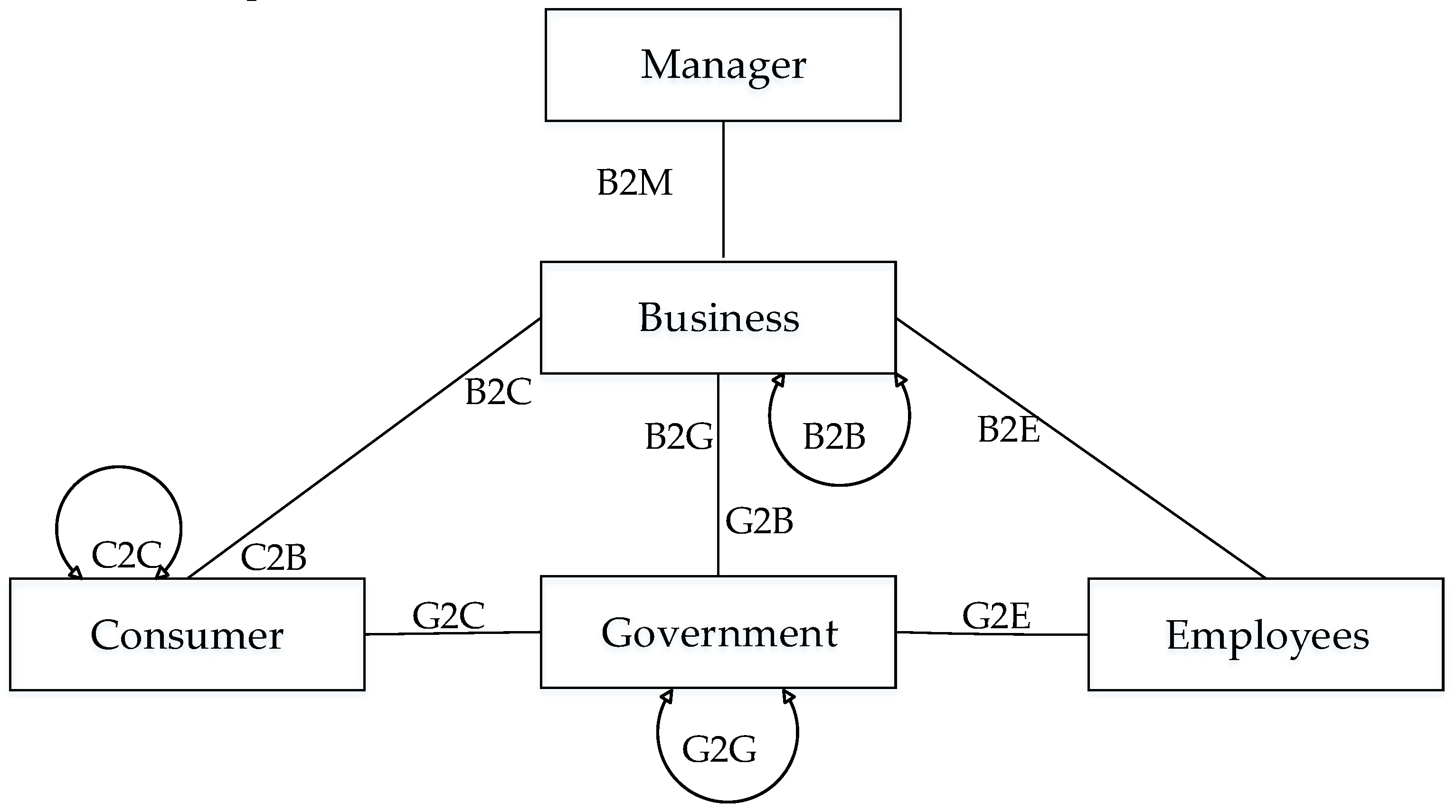

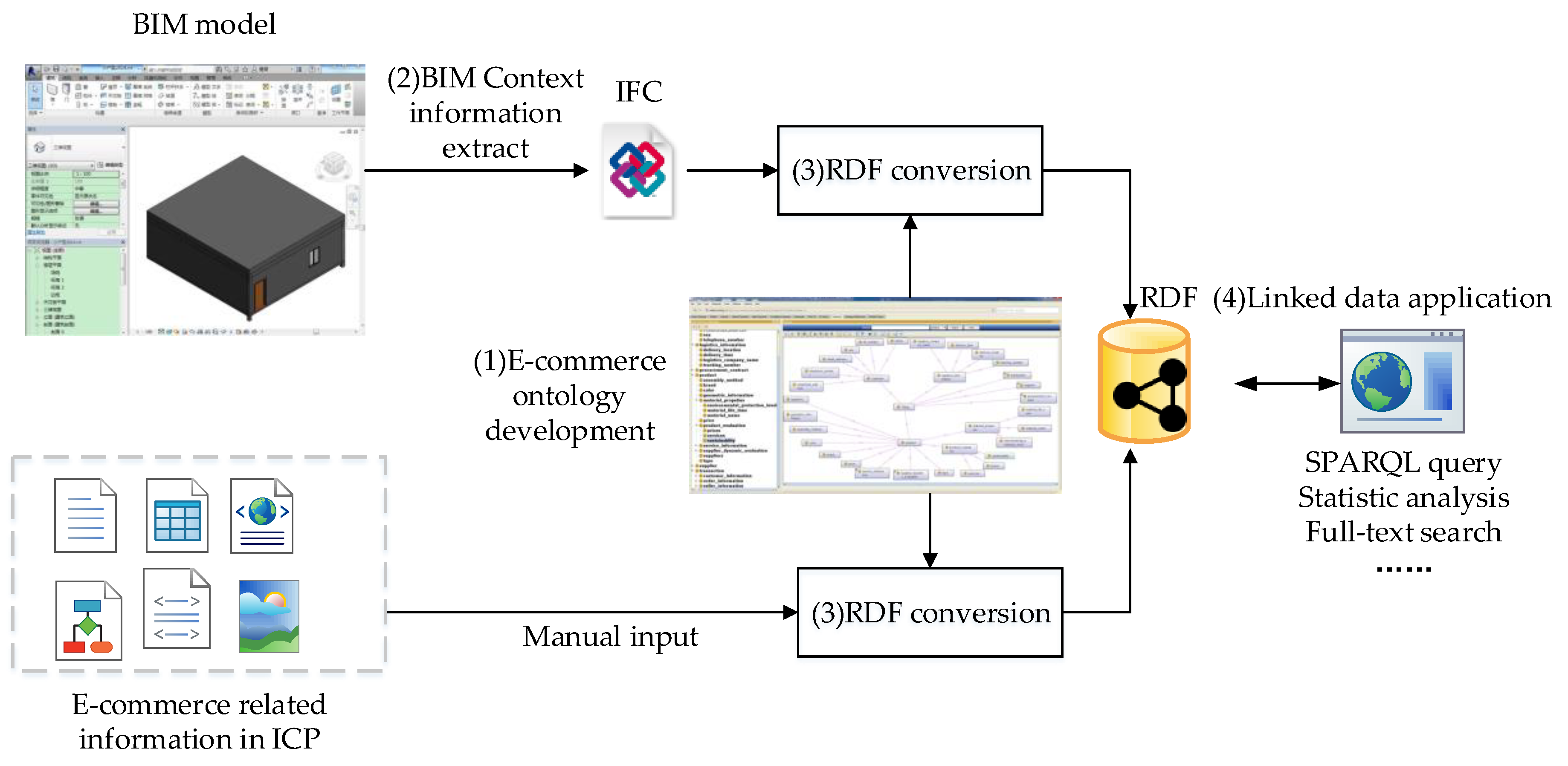
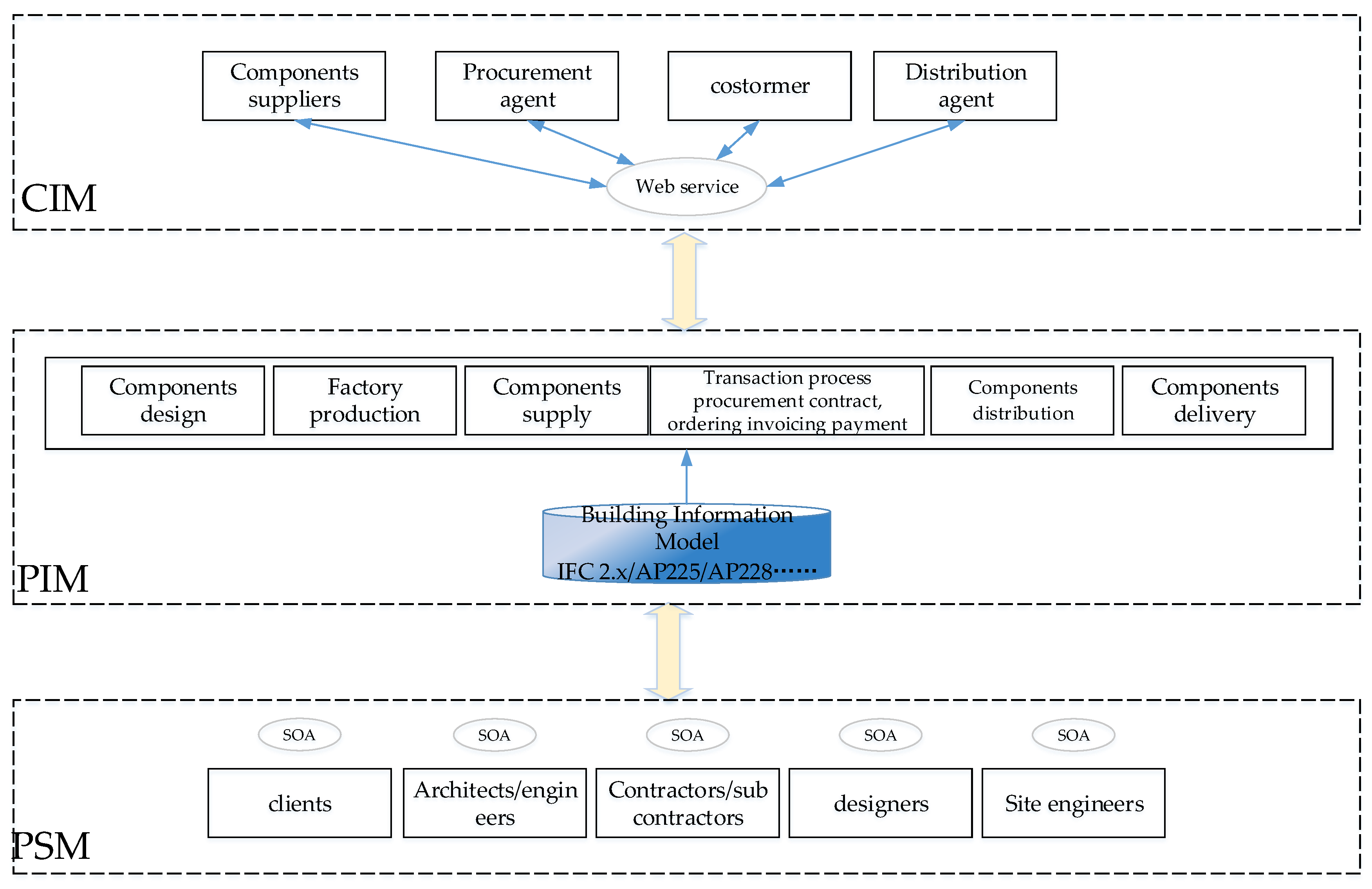

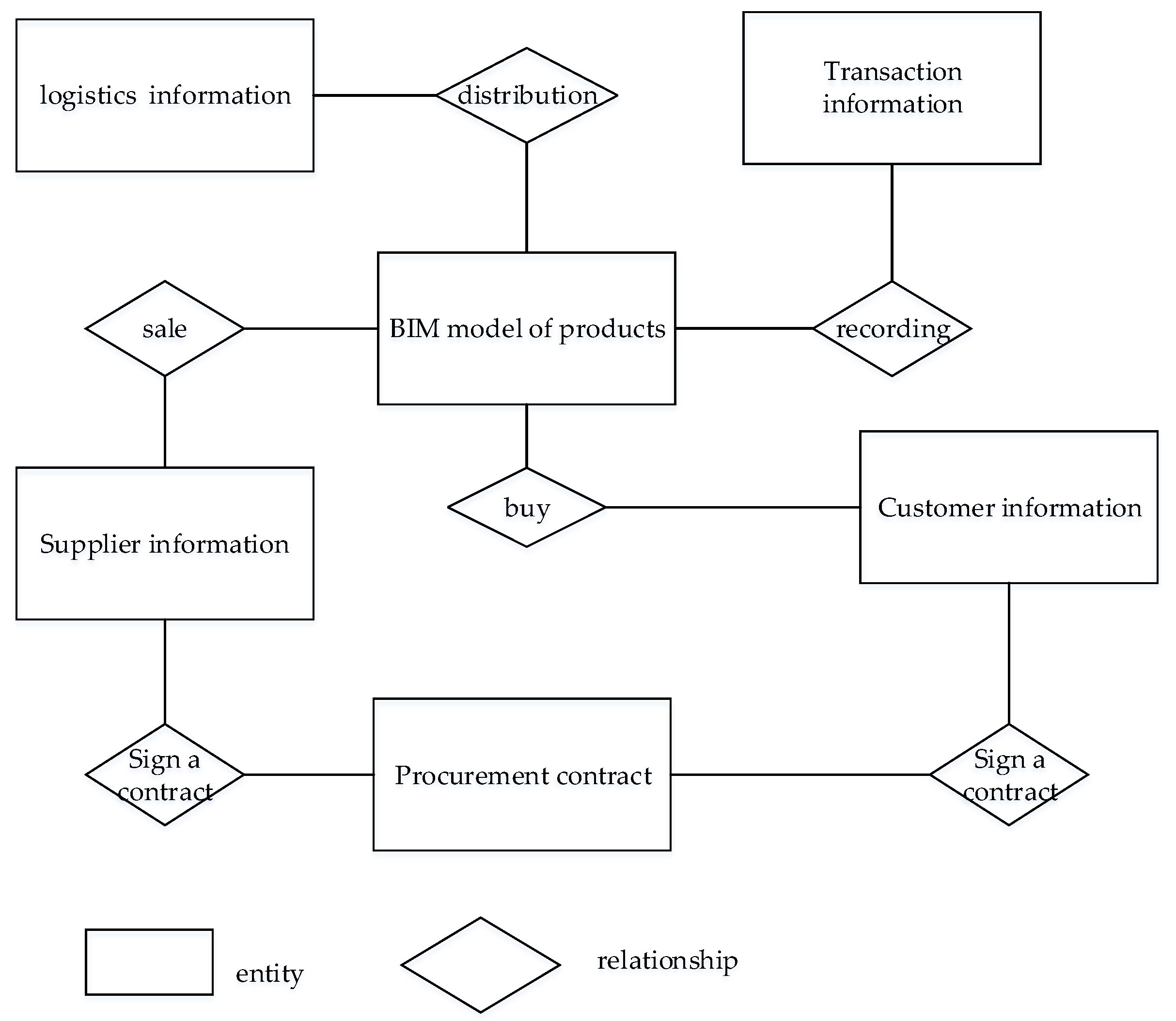
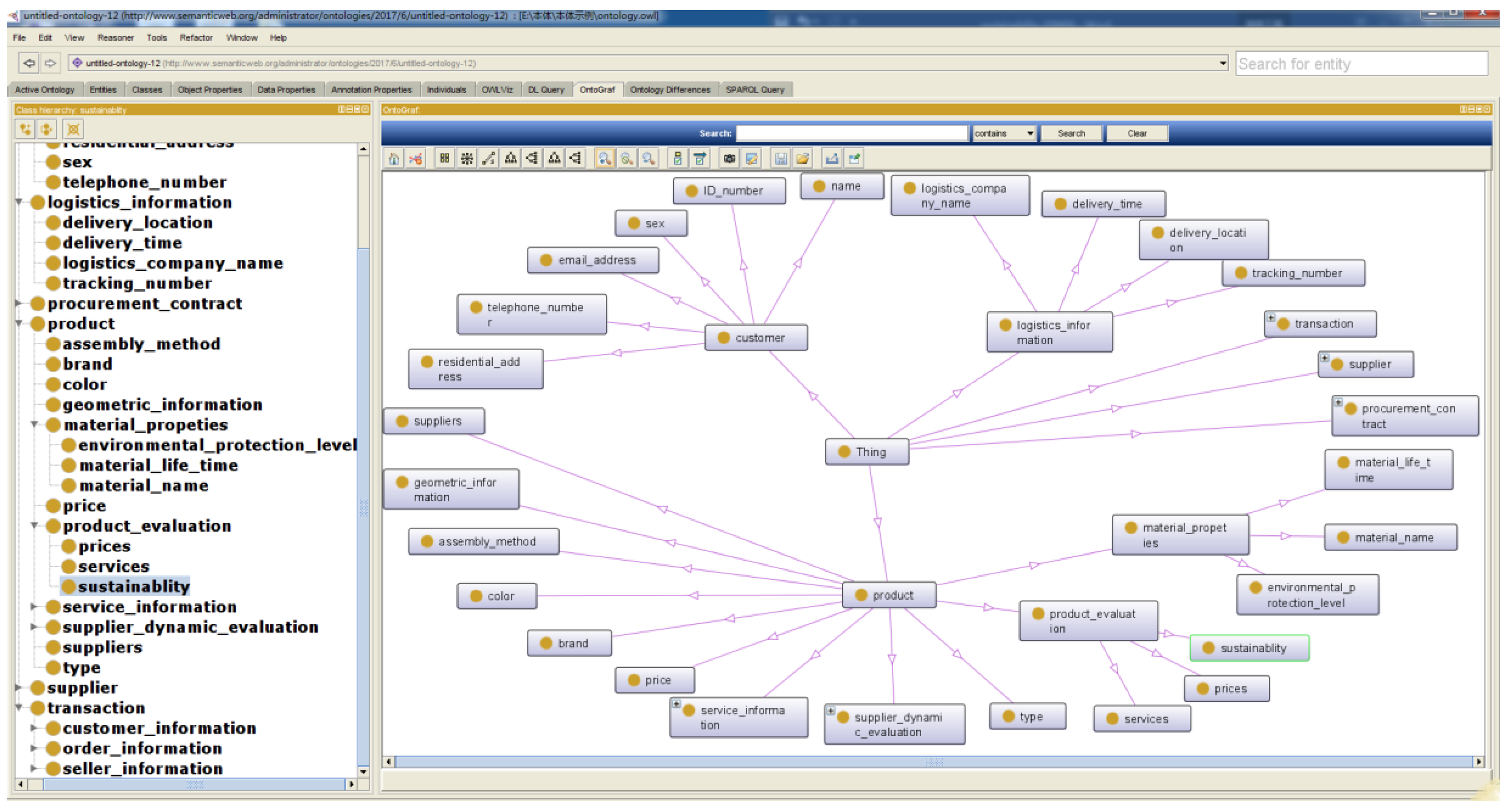
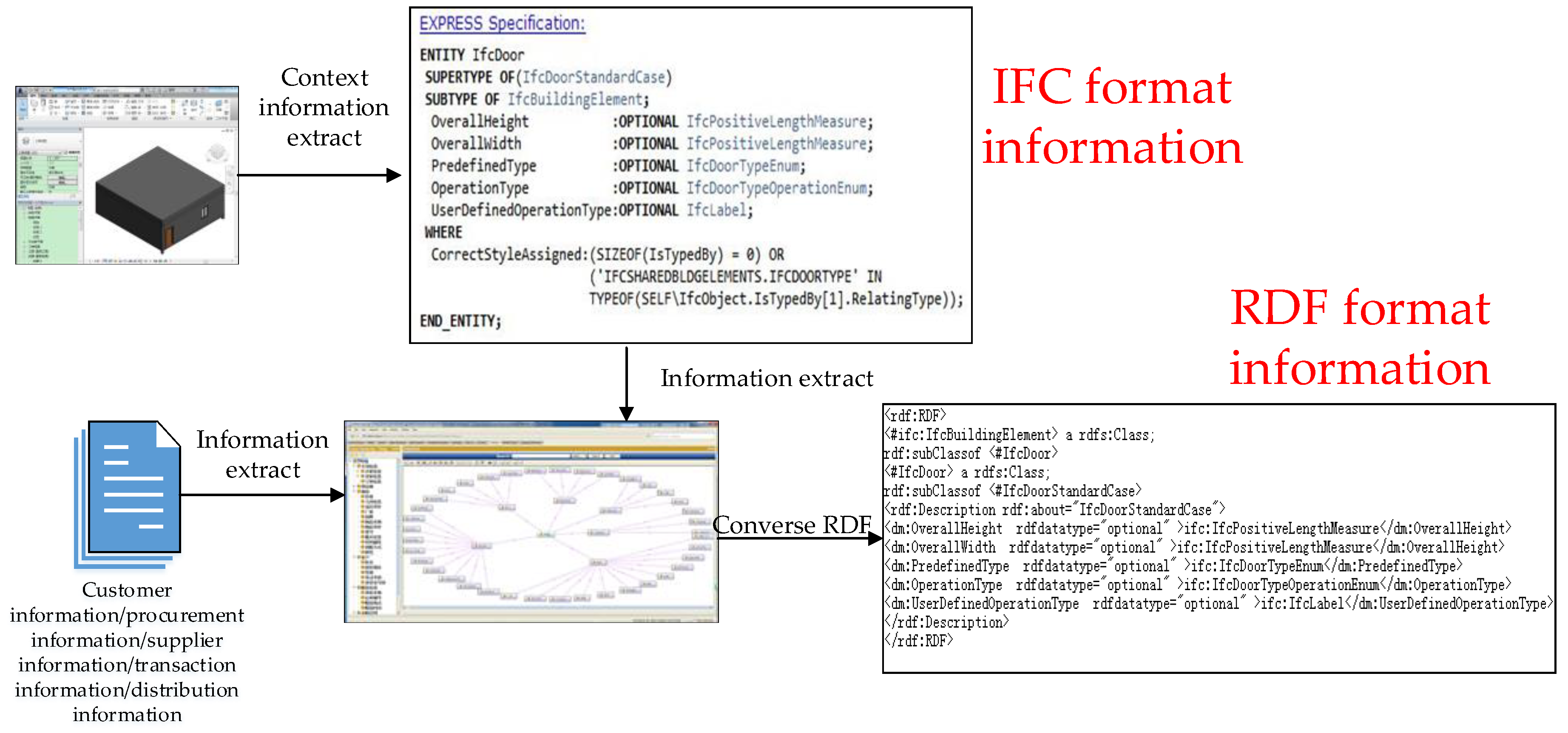
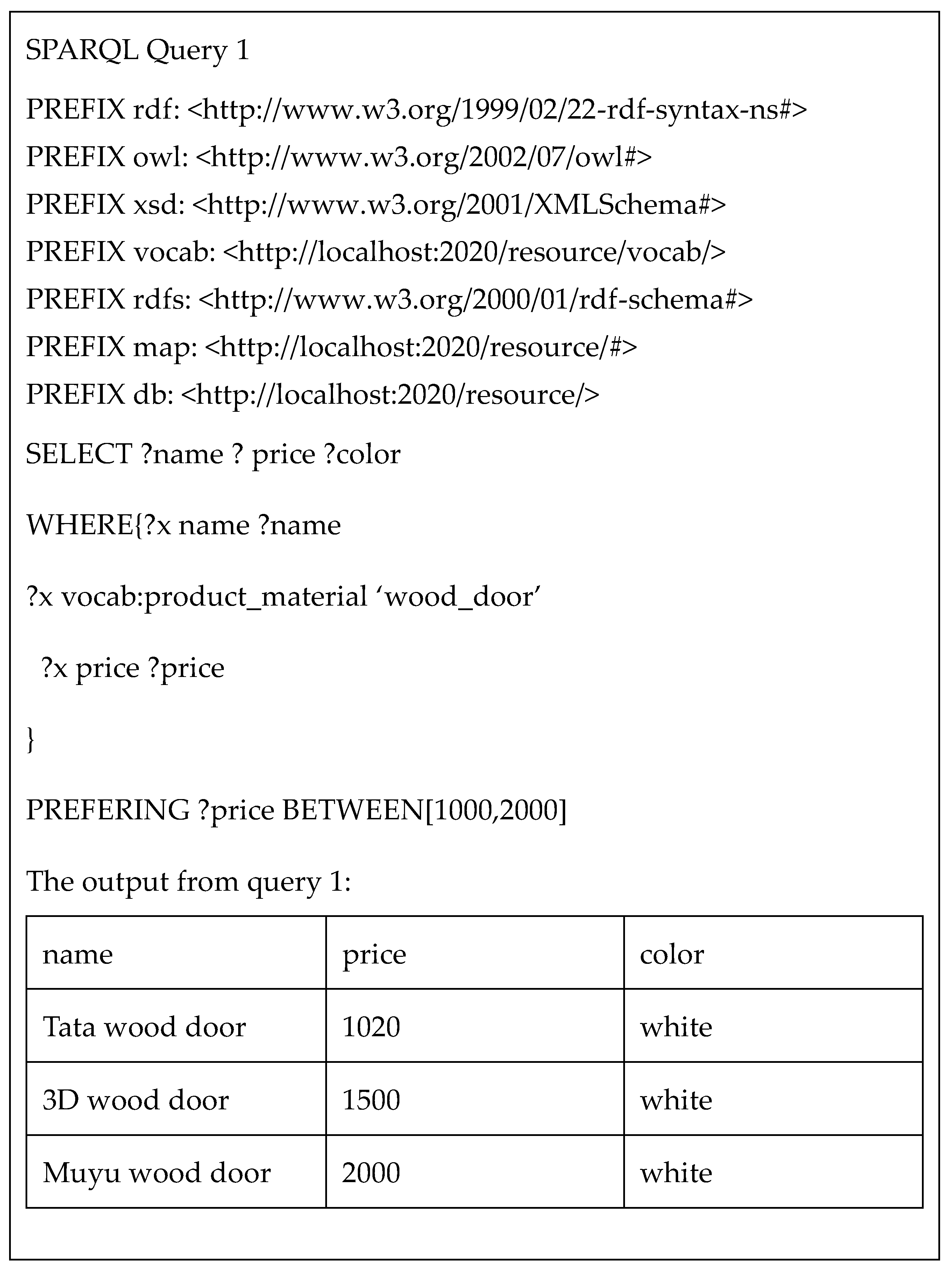
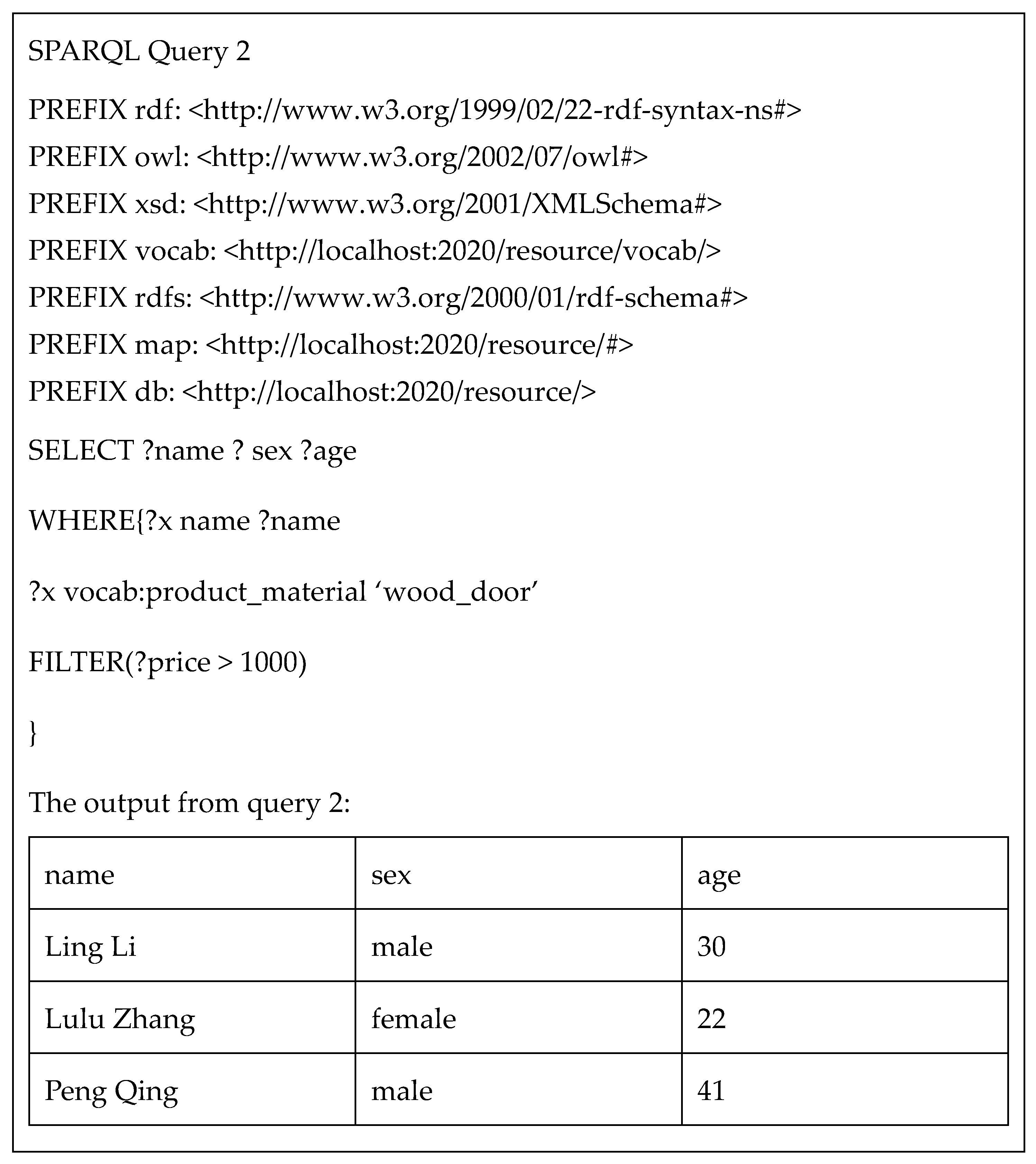
| Entity Name | Entity Description | Sub-Entity Description |
|---|---|---|
| 1. Supplier information | 1.1. Supplier name | |
| 1.2. Credit rating | ||
| 1.3. Registration code | ||
| 1.4. Setup time | ||
| 1.5. Address | ||
| 1.6. Products | ||
| 1.7. Legal representative | ||
| 1.8. Financial information | ||
| 1.9. Assessment information | 1.9.1. Product description match | |
| 1.9.2. Seller’ service attitude | ||
| 1.9.3. Logistics service attitude | ||
| 1.10. Service situation | 1.10.1. Transaction rate | |
| 1.10.2. Refund rate | ||
| 2. Customer information | 2.1. ID number | |
| 2.2. Name | ||
| 2.3. Sex | ||
| 2.4. Age | ||
| 2.5. Residential address | ||
| 2.6. Telephone number | ||
| 2.7. Email address | ||
| 3. Transaction information | 3.1. Seller information | 3.1.1. Seller Name |
| 3.1.2. Seller Address | ||
| 3.1.3. Seller Phone | ||
| 3.1.4. Seller Emil address | ||
| 3.2. Customer information | 3.2.1. Customer Name | |
| 3.2.2. Customer Address | ||
| 3.2.3. Customer phone | ||
| 3.3. Order information | 3.3.1. Transaction record | |
| 3.3.2. Transaction amount | ||
| 3.3.3. Transaction frequency | ||
| 4. logistics information | 4.1. Logistics company name | |
| 4.2. Tracking number | ||
| 4.3. Delivery time | ||
| 4.4. Delivery location | ||
| 5. Procurement contract | 5.1. Contract number | |
| 5.2. Time | ||
| 5.3. Object | ||
| 5.4. Content | ||
| 6. Product information | Part 1. Stored on e-commerce platform | |
| 6.1. Price | ||
| 6.2. Color | ||
| 6.3. Brand | ||
| 6.4. Suppliers | ||
| 6.5. Assembly method | ||
| 6.6. Product evaluation | 6.6.1. Sustainability | |
| 6.6.2. Price | ||
| 6.6.3. Service | ||
| 6.7. Supplier dynamic evaluation | 6.7.1. Consistent description | |
| 6.7.2. Delivery speed | ||
| 6.7.3. Service attitude | ||
| 6.8. Service information | 6.8.1. Claims | |
| 6.8.2. Return rate | ||
| 6.8.3. Return time | ||
| 6.8.4. Number of punishments | ||
| Part 2. Stored in BIM model | ||
| 6.9. Geometric information | ||
| 6.10. Material properties | 6.9.1. Material name | |
| 6.9.2. Material life time | ||
| 6.9.2. Environmental protection level | ||
| 6.11. type |
| Key Words | Proposed Platform | Taobao.com | ||||
|---|---|---|---|---|---|---|
| Total Records | Relevant/The First Ten Records | Precision | Total Records | Relevant/The First Ten Records | Precision | |
| “aluminium alloy door” | 1061 | 10/10 | 0.85 | 5200 | 10/10 | 0.45 |
| “aluminium alloy door” and “1000 < price < 2000” | 19 | 10/10 | 0.74 | 28 | 7/10 | 0.45 |
| Experts | Type | Working Experience (Years) | Time Using of E-Commerce Platforms (Years) |
|---|---|---|---|
| 1 | Project manager | 5 | 10 |
| 2 | Site superintendent | 7 | 11 |
| 3 | Formwork manager | 3 | 10 |
| 4 | Chief estimator | 7 | 13 |
| Evaluation Criteria | Performance Indicator | Choice of Proposed Platform (1 to 5) | Choice of taobao.com (1 to 5) | ||||||
|---|---|---|---|---|---|---|---|---|---|
| E1 | E2 | E3 | E4 | E1 | E2 | E3 | E4 | ||
| Cost [57] | Total cost | 3 | 3 | 3 | 2 | 4 | 3 | 2 | 2 |
| Price stability | 5 | 2 | 3 | 4 | 1 | 3 | 2 | 1 | |
| Discount rate | 3 | 3 | 3 | 3 | 3 | 3 | 3 | 3 | |
| Quality [57] | Return rate | 4 | 1 | 2 | 5 | 4 | 4 | 2 | 1 |
| Failure prevention | 3 | 3 | 3 | 3 | 3 | 2 | 2 | 1 | |
| Appearance and function | 5 | 4 | 4 | 4 | 3 | 3 | 3 | 3 | |
| Service [16] | User interface | 5 | 5 | 5 | 5 | 3 | 4 | 2 | 5 |
| Service standard | 5 | 4 | 5 | 3 | 1 | 2 | 1 | 1 | |
| Technical assistance and support | 5 | 5 | 5 | 5 | 4 | 4 | 3 | 5 | |
| Response time | 4 | 5 | 3 | 3 | 3 | 5 | 3 | 1 | |
| Links service | 5 | 5 | 5 | 5 | 1 | 3 | 2 | 2 | |
| Information sharing [16] | Use of electronic data interchange | 4 | 5 | 5 | 5 | 1 | 1 | 1 | 1 |
| Willing to share sensitive information | 5 | 5 | 5 | 5 | 2 | 1 | 1 | 1 | |
| Search performance | Precision | 5 | 5 | 5 | 5 | 5 | 5 | 5 | 5 |
| Recall | 5 | 5 | 5 | 5 | 5 | 5 | 5 | 5 | |
| Overall ability | Technical ability [16] | 5 | 5 | 5 | 4 | 3 | 3 | 3 | 4 |
| Conform to BIM standard [16] | 5 | 5 | 5 | 5 | 1 | 1 | 1 | 1 | |
| Data scale and content | 5 | 4 | 5 | 3 | 5 | 3 | 3 | 3 | |
| Evaluation Criteria | Performance Indicator | Choice of Proposed Platform | Choice of taobao.com |
|---|---|---|---|
| Cost | Total cost | 11 | 11 |
| Price stability | 14 | 7 | |
| Discount rate | 12 | 12 | |
| 37 | 30 | ||
| Quality | Return rate | 12 | 11 |
| Failure prevention | 12 | 8 | |
| Appearance and function | 17 | 12 | |
| 41 | 31 | ||
| service | User interface | 20 | 14 |
| Service standard | 17 | 5 | |
| Technical assistance and support | 20 | 16 | |
| Responsive time | 15 | 12 | |
| Links service | 20 | 8 | |
| 92 | 55 | ||
| Information sharing | Use of electronic data interchange | 19 | 4 |
| Willing to share sensitive information | 20 | 5 | |
| 39 | 9 | ||
| Search performance | precision | 20 | 20 |
| recall | 20 | 20 | |
| 40 | 40 | ||
| Overall ability | Technical ability | 19 | 13 |
| Conform to BIM standard | 20 | 4 | |
| Data scale and content | 17 | 14 | |
| 56 | 31 |
© 2018 by the authors. Licensee MDPI, Basel, Switzerland. This article is an open access article distributed under the terms and conditions of the Creative Commons Attribution (CC BY) license (http://creativecommons.org/licenses/by/4.0/).
Share and Cite
He, D.; Li, Z.; Wu, C.; Ning, X. An E-Commerce Platform for Industrialized Construction Procurement Based on BIM and Linked Data. Sustainability 2018, 10, 2613. https://doi.org/10.3390/su10082613
He D, Li Z, Wu C, Ning X. An E-Commerce Platform for Industrialized Construction Procurement Based on BIM and Linked Data. Sustainability. 2018; 10(8):2613. https://doi.org/10.3390/su10082613
Chicago/Turabian StyleHe, Dandan, Zhongfu Li, Chunlin Wu, and Xin Ning. 2018. "An E-Commerce Platform for Industrialized Construction Procurement Based on BIM and Linked Data" Sustainability 10, no. 8: 2613. https://doi.org/10.3390/su10082613
APA StyleHe, D., Li, Z., Wu, C., & Ning, X. (2018). An E-Commerce Platform for Industrialized Construction Procurement Based on BIM and Linked Data. Sustainability, 10(8), 2613. https://doi.org/10.3390/su10082613







